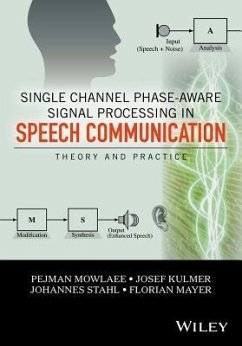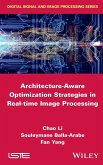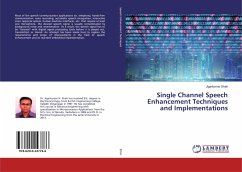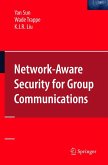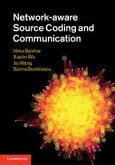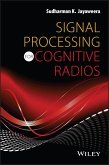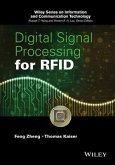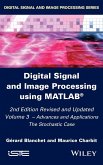Pejman Mowlaee, Josef Kulmer, Johannes Stahl, Florian Mayer
Single Channel Phase-Aware Signal Processing in Speech Communication
Theory and Practice
Pejman Mowlaee, Josef Kulmer, Johannes Stahl, Florian Mayer
Single Channel Phase-Aware Signal Processing in Speech Communication
Theory and Practice
- Gebundenes Buch
- Merkliste
- Auf die Merkliste
- Bewerten Bewerten
- Teilen
- Produkt teilen
- Produkterinnerung
- Produkterinnerung
An overview on the challenging new topic of phase-aware signal processing Speech communication technology is a key factor in human-machine interaction, digital hearing aids, mobile telephony, and automatic speech/speaker recognition. With the proliferation of these applications, there is a growing requirement for advanced methodologies that can push the limits of the conventional solutions relying on processing the signal magnitude spectrum. Single-Channel Phase-Aware Signal Processing in Speech Communication provides a comprehensive guide to phase signal processing and reviews the history of…mehr
Andere Kunden interessierten sich auch für
![Architecture-Aware Optimization Strategies in Real-Time Image Processing Architecture-Aware Optimization Strategies in Real-Time Image Processing]() Chao LiArchitecture-Aware Optimization Strategies in Real-Time Image Processing164,99 €
Chao LiArchitecture-Aware Optimization Strategies in Real-Time Image Processing164,99 €![Single Channel Speech Enhancement Techniques and Implementations Single Channel Speech Enhancement Techniques and Implementations]() Jigarkumar ShahSingle Channel Speech Enhancement Techniques and Implementations47,99 €
Jigarkumar ShahSingle Channel Speech Enhancement Techniques and Implementations47,99 €![Network-Aware Security for Group Communications Network-Aware Security for Group Communications]() Yan SunNetwork-Aware Security for Group Communications75,99 €
Yan SunNetwork-Aware Security for Group Communications75,99 €![Network-Aware Source Coding and Communication Network-Aware Source Coding and Communication]() Nima SarsharNetwork-Aware Source Coding and Communication100,99 €
Nima SarsharNetwork-Aware Source Coding and Communication100,99 €![Signal Processing for Cognitive Radios Signal Processing for Cognitive Radios]() Sudharman K JayaweeraSignal Processing for Cognitive Radios139,99 €
Sudharman K JayaweeraSignal Processing for Cognitive Radios139,99 €![Digital Signal Processing for RFID Digital Signal Processing for RFID]() Feng ZhengDigital Signal Processing for RFID124,99 €
Feng ZhengDigital Signal Processing for RFID124,99 €![Digital Signal and Image Processing Using Matlab, Volume 3 Digital Signal and Image Processing Using Matlab, Volume 3]() Gérard BlanchetDigital Signal and Image Processing Using Matlab, Volume 3164,99 €
Gérard BlanchetDigital Signal and Image Processing Using Matlab, Volume 3164,99 €-
-
-
An overview on the challenging new topic of phase-aware signal processing Speech communication technology is a key factor in human-machine interaction, digital hearing aids, mobile telephony, and automatic speech/speaker recognition. With the proliferation of these applications, there is a growing requirement for advanced methodologies that can push the limits of the conventional solutions relying on processing the signal magnitude spectrum. Single-Channel Phase-Aware Signal Processing in Speech Communication provides a comprehensive guide to phase signal processing and reviews the history of phase importance in the literature, basic problems in phase processing, fundamentals of phase estimation together with several applications to demonstrate the usefulness of phase processing. Key features: * Analysis of recent advances demonstrating the positive impact of phase-based processing in pushing the limits of conventional methods. * Offers unique coverage of the historical context, fundamentals of phase processing and provides several examples in speech communication. * Provides a detailed review of many references and discusses the existing signal processing techniques required to deal with phase information in different applications involved with speech. * The book supplies various examples and MATLAB(R) implementations delivered within the PhaseLab toolbox. Single-Channel Phase-Aware Signal Processing in Speech Communication is a valuable single-source for students, non-expert DSP engineers, academics and graduate students.
Produktdetails
- Produktdetails
- Verlag: Wiley
- Seitenzahl: 256
- Erscheinungstermin: 27. Dezember 2016
- Englisch
- Abmessung: 246mm x 173mm x 18mm
- Gewicht: 544g
- ISBN-13: 9781119238812
- ISBN-10: 1119238811
- Artikelnr.: 47086110
- Herstellerkennzeichnung
- Libri GmbH
- Europaallee 1
- 36244 Bad Hersfeld
- gpsr@libri.de
- Verlag: Wiley
- Seitenzahl: 256
- Erscheinungstermin: 27. Dezember 2016
- Englisch
- Abmessung: 246mm x 173mm x 18mm
- Gewicht: 544g
- ISBN-13: 9781119238812
- ISBN-10: 1119238811
- Artikelnr.: 47086110
- Herstellerkennzeichnung
- Libri GmbH
- Europaallee 1
- 36244 Bad Hersfeld
- gpsr@libri.de
Pejman Mowlaee, Graz University of Technology, Austria Dr. Mowlaee is a Senior Research and Teaching Associate at the Speech Communication and Signal Processing Laboratory, Graz University of Technology, Austria. He has received several awards including best M.Sc. thesis, awarded by the National Scientific Students' Organization of Electrical Engineering in 2007; and was a member of the organizing committee for the annual European Signal Processing Conference in 2010 in Aalborg and AUDIS workshop 2012 in Aachen. He has contributed over 40 journal and conference articles; he is a senior member of IEEE, acted as a reviewer for a number of journals, and has played an active role in organizing special sessions on the topic of the book at INTERSPEECH conferences. Dr. Mowlaee is also Guest Editor for the forthcoming Special Issue in Speech Communication (Elsevier) on Phase-Aware Signal Processing for Speech Communication. Johannes Stahl, Graz University of Technology, Austria In 2009, Johannes started studying Electrical Engineering and Audio Engineering, at Graz University of Technology. In 2015, he received his Dipl.-Ing. (MSc) degree with distinction. In 2015 he joined the Signal Processing and Speech Communication Laboratory, at Graz University of Technology, where he is currently pursuing his PhD thesis in the field of speech processing. Josef Kulmer, Graz University of Technology, Austria Josef received the M.Sc. degree from Graz University of Technology, Austria, in 2014. In 2014 he joined the Signal Processing and Speech Communication Laboratory, at Graz, University of Technology, where he is currently pursuing his PhD thesis in the field of signal processing. Florian Mayer, Graz University of Technology, Austria In 2006, Florian started studying Electrical Engineering and Audio Engineering, at Graz University of Technology, and received his Dipl.-Ing. (MSc) in 2015. In 2015 he joined the Signal Processing and Speech Communication Laboratory, at Graz University of Technology, where he is currently pursuing his PhD thesis in the field of speech processing.
About the Authors xi
Preface xiii
List of Symbols xvii
Part I History, Theory and Concepts 1
1 Introduction: Phase Processing, History 3
Pejman Mowlaee
1.1 Chapter Organization 3
1.2 Conventional Speech Communication 3
1.3 Historical Overview of the Importance or Unimportance of Phase 6
1.4 Importance of Phase in Speech Processing 9
1.4.1 Speech Enhancement 9
1.4.1.1 Unimportance of Phase in Speech Enhancement 10
1.4.1.2 Effects of Phase Modification in Speech Signals 10
1.4.1.3 Phase Spectrum Compensation 10
1.4.1.4 Phase Importance for Improved Signal Reconstruction 11
1.4.2 Speech Watermarking 11
1.4.3 Speech Coding 12
1.4.4 Artificial Bandwidth Extension 13
1.4.5 Speech Synthesis 14
1.4.6 Speech/Speaker Recognition 15
1.5 Structure of the Book 16
1.6 Experiments 18
1.6.1 Experiment 1.1: Phase Unimportance in Speech Enhancement 18
1.6.2 Experiment 1.2: Effects of Phase Modification 20
1.6.3 Experiment 1.3: Mismatched Window 22
1.6.4 Experiment 1.4: Phase Spectrum Compensation 24
1.7 Summary 26
References 26
2 Fundamentals of Phase-Based Signal Processing 33
Pejman Mowlaee
2.1 Chapter Organization 33
2.2 STFT Phase: Background and Some Remarks 33
2.2.1 Short-Time Fourier Transform 33
2.2.2 Fourier Analysis of Speech: STFT Amplitude and Phase 34
2.3 Phase Unwrapping 35
2.3.1 Problem Definition 35
2.3.2 Remarks on Phase Unwrapping 38
2.3.3 Phase Unwrapping Solutions 38
2.3.3.1 Detecting Discontinuities 39
2.3.3.2 Numerical Integration (NI) 40
2.3.3.3 Isolating Sharp Zeros 41
2.3.3.4 Iterative Phase Unwrapping 41
2.3.3.5 Polynomial Factorization (PF) 42
2.3.3.6 Time Series Approach 42
2.3.3.7 Composite Method 43
2.3.3.8 Schur-Cohn and Nyquist Frequency 44
2.4 Useful Phase-Based Representations 44
2.4.1 Group Delay Representations 45
2.4.2 Instantaneous Frequency 48
2.4.3 Baseband Phase Difference 49
2.4.4 Harmonic Phase Decomposition 50
2.4.4.1 Background on the Harmonic Model 50
2.4.4.2 Phase Decomposition using the Harmonic Model 51
2.4.5 Phasegram: Unwrapped Harmonic Phase 52
2.4.5.1 Definitions and Background 52
2.4.5.2 Circular Mean and Variance 52
2.4.6 Relative Phase Shift 53
2.4.7 Phase Distortion 54
2.5 Experiments 57
2.5.1 Experiment 2.1: One-Dimensional Phase Unwrapping 57
2.5.1.1 Clean Signal Scenario 57
2.5.1.2 Noisy Signal Scenario 58
2.5.2 Experiment 2.2: Comparative Study of Phase Unwrapping Methods 58
2.5.3 Experiment 2.3: Comparative Study on Group Delay Spectra 59
2.5.4 Experiment 2.4: Circular Statistics of the Harmonic Phase 60
2.5.5 Experiment 2.5: Circular Statistics of the Spectral Phase 62
2.5.6 Experiment 2.6: Comparative Study of Phase Representations 63
2.6 Summary 65
References 65
3 Phase Estimation Fundamentals 71
Josef Kulmer and Pejman Mowlaee
3.1 Chapter Organization 71
3.2 Phase Estimation Fundamentals 71
3.2.1 Background and Fundamentals 71
3.2.2 Key Examples: Phase Estimation Problem 72
3.2.2.1 Example 1: Discrete-Time Sinusoid 72
3.2.2.2 Example 2: Discrete-Time Sinusoid in Noise 76
3.2.3 Phase Estimation 80
3.2.3.1 Maximum Likelihood Estimation 80
3.2.3.2 Maximum a Posteriori Estimation 83
3.3 Existing Solutions 84
3.3.1 Iterative Signal Reconstruction 84
3.3.1.1 Background 84
3.3.1.2 Griffin-Lim Algorithm (GLA) 85
3.3.1.3 Extensions of the GLA 87
3.3.2 Phase Reconstruction Across Time 89
3.3.3 Phase Reconstruction Across Frequency 90
3.3.4 Phase Randomization 91
3.3.5 Geometry-Based Phase Estimation 93
3.3.6 Least Squares (LS) 95
3.3.7 Spectro-Temporal Smoothing of Unwrapped Phase 97
3.3.7.1 Signal Segmentation 97
3.3.7.2 Linear Phase Removal 98
3.3.7.3 Apply Smoothing Filter 98
3.3.7.4 Reconstruction of the Enhanced-Phase Signal 101
3.4 Experiments 101
3.4.1 Experiment 3.1: Monte Carlo Simulation Comparing ML and MAP 101
3.4.2 Experiment 3.2: Monte Carlo Simulation on Window Impact 103
3.4.3 Experiment 3.3: Phase Recovery Using the Griffin-Lim Algorithm 105
3.4.4 Experiment 3.4: Phase Estimation for Speech Enhancement: A
Comparative Study 105
3.5 Summary 107
References 108
Part II Applications 113
4 Phase Processing for Single-Channel Speech Enhancement 115
Johannes Stahl and Pejman Mowlaee
4.1 Introduction and Chapter Organization 115
4.2 Speech Enhancement in the STFT Domain: General Concepts 116
4.2.1 A priori SNR Estimation 116
4.2.1.1 Decision-Directed a priori SNR Estimation 117
4.2.1.2 Cepstro-Temporal Smoothing 118
4.2.2 Noise PSD Estimation 118
4.2.2.1 Minimum Statistics 119
4.3 Conventional Speech Enhancement 119
4.3.1 Statistical Model 119
4.3.2 Short-Time Spectral Amplitude Estimation 121
4.4 Phase-Sensitive Speech Enhancement 123
4.4.1 Phase Estimation for Signal Reconstruction 123
4.4.2 Spectral Amplitude Estimation Given the STFT Phase 124
4.4.3 Iterative Closed-Loop Phase-Aware Single-Channel Speech Enhancement
126
4.4.4 Incorporating Voiced/Unvoiced Uncertainty 128
4.4.5 Uncertainty in Prior Phase Information 130
4.4.6 Stochastic-Deterministic MMSE-STFT Speech Enhancement 131
4.4.6.1 Obtaining the Speech Parameters 134
4.5 Experiments 135
4.5.1 Experiment 4.1: Proof of Concept 135
4.5.2 Experiment 4.2: Consistency 136
4.5.3 Experiment 4.3: Sensitivity Analysis 137
4.6 Summary 139
References 139
5 Phase Processing for Single-Channel Source Separation 143
Pejman Mowlaee and Florian Mayer
5.1 Chapter Organization 143
5.2 Why Single-Channel Source Separation? 143
5.2.1 Background 143
5.2.2 Problem Formulation 144
5.3 Conventional Single-Channel Source Separation 145
5.3.1 Source-Driven SCSS 146
5.3.1.1 Ideal Binary Mask 147
5.3.1.2 Ideal Ratio Mask 147
5.3.2 Model-Based SCSS 147
5.3.2.1 Deep Learning 149
5.3.2.2 Non-NegativeMatrix Factorization 150
5.4 Phase Processing for Single-Channel Source Separation 152
5.4.1 Complex Matrix Factorization Methods 152
5.4.1.1 Complex Matrix Factorization 152
5.4.1.2 Complex Matrix Factorization with Intra-Source Additivity 154
5.4.2 Phase Importance for Signal Reconstruction 155
5.4.2.1 Multiple Input Spectrogram Inversion 155
5.4.2.2 Partial Phase Reconstruction 156
5.4.2.3 Informed Source Separation Using Iterative Reconstruction (ISSIR)
157
5.4.2.4 Sinusoidal-Based PPR 158
5.4.2.5 Spectrogram Consistency 159
5.4.2.6 Geometry-Based Phase Estimation 160
5.4.2.7 Phase Decomposition and Temporal Smoothing 162
5.4.2.8 Phase Reconstruction of Spectrograms with Linear Unwrapping 163
5.4.3 Phase-Aware Time-Frequency Masks 164
5.4.3.1 Phase-Insensitive Masks 164
5.4.3.2 Phase-Sensitive Mask 165
5.4.3.3 Complex Ratio Mask 165
5.4.3.4 Complex Mask 166
5.4.4 Phase Importance in Signal Interaction Models 166
5.5 Experiments 168
5.5.1 Experiment 5.1: Phase Estimation for Proof-of-Concept Signal
Reconstruction 168
5.5.2 Experiment 5.2: Comparative Study of GLA-Based Phase Reconstruction
Methods 168
5.5.2.1 Convergence Analysis 169
5.5.2.2 Quantized Scenario 169
5.5.3 Experiment 5.3: Phase-Aware Time-Frequency Mask 170
5.5.4 Experiment 5.4: Phase-Sensitive Interaction Functions 172
5.5.5 Experiment 5.5: Complex Matrix Factorization 172
5.6 Summary 174
References 174
6 Phase-Aware Speech Quality Estimation 179
Pejman Mowlaee
6.1 Chapter Organization 179
6.2 Introduction: Speech Quality Estimation 179
6.2.1 General Definition of Speech Quality 180
6.2.2 Speech Quality Estimators: Amplitude, Phase, or Both? 181
6.3 Conventional Instrumental Metrics for Speech Quality Estimation 182
6.3.1 Perceived Quality 182
6.3.2 Speech Intelligibility 184
6.4 Why Phase-Aware Metrics? 188
6.4.1 Phase and Speech Intelligibility 188
6.4.2 Phase and Perceived Quality 188
6.5 New Phase-Aware Metrics 189
6.5.1 Group Delay Deviation 189
6.5.2 Instantaneous Frequency Deviation 190
6.5.3 Unwrapped MSE 190
6.5.4 Phase Deviation 190
6.5.5 UnHPSNR and UnRMSE 191
6.6 Subjective Tests 191
6.6.1 CCR Test 192
6.6.2 MUSHRA Test 192
6.6.3 Statistical Analysis 193
6.6.4 Speech Intelligibility Test 194
6.6.5 Evaluation of Speech Quality Measures 196
6.7 Experiments 198
6.7.1 Experiment 6.1: Impact of Phase Modifications on Speech Quality 199
6.7.2 Experiment 6.2: Phase and Perceived Quality Estimation 201
6.7.3 Experiment 6.3: Phase and Speech Intelligibility Estimation 202
6.7.4 Experiment 6.4: Evaluating the Phase Estimation Accuracy 203
6.8 Summary 205
References 205
7 Conclusion and Future Outlook 210
Pejman Mowlaee
7.1 Chapter Organization 210
7.2 Renaissance of Phase-Aware Signal Processing: Decline and Rise 210
7.3 Directions for Future Research 211
7.3.1 Related Research Disciplines 212
7.3.1.1 Phase-Aware Processing for Speech and Speaker Recognition 212
7.3.1.2 Speech Synthesis and Speech Coding 212
7.3.1.3 Phase-Aware Speech Enhancement for De-Reverberation 213
7.3.1.4 Iterative Signal Estimation 213
7.3.1.5 More Robust Phase Estimators 214
7.3.1.6 Instrumental Measures in Complex Signal Domain 214
7.3.1.7 Multi-Channel Speech Processing 214
7.3.2 Other Research Disciplines 215
7.3.2.1 Processing Non-Speech Signals 215
7.3.2.2 Processing Signals of Higher Dimensionality Than One 215
7.4 Summary 215
References 216
A MATLAB Toolbox 220
A.1 Chapter Organization 220
A.2 Phase Lab Toolbox 220
A.2.1 MATLAB® Code 220
A.2.2 Additional Material 221
References 221
Index 223
Preface xiii
List of Symbols xvii
Part I History, Theory and Concepts 1
1 Introduction: Phase Processing, History 3
Pejman Mowlaee
1.1 Chapter Organization 3
1.2 Conventional Speech Communication 3
1.3 Historical Overview of the Importance or Unimportance of Phase 6
1.4 Importance of Phase in Speech Processing 9
1.4.1 Speech Enhancement 9
1.4.1.1 Unimportance of Phase in Speech Enhancement 10
1.4.1.2 Effects of Phase Modification in Speech Signals 10
1.4.1.3 Phase Spectrum Compensation 10
1.4.1.4 Phase Importance for Improved Signal Reconstruction 11
1.4.2 Speech Watermarking 11
1.4.3 Speech Coding 12
1.4.4 Artificial Bandwidth Extension 13
1.4.5 Speech Synthesis 14
1.4.6 Speech/Speaker Recognition 15
1.5 Structure of the Book 16
1.6 Experiments 18
1.6.1 Experiment 1.1: Phase Unimportance in Speech Enhancement 18
1.6.2 Experiment 1.2: Effects of Phase Modification 20
1.6.3 Experiment 1.3: Mismatched Window 22
1.6.4 Experiment 1.4: Phase Spectrum Compensation 24
1.7 Summary 26
References 26
2 Fundamentals of Phase-Based Signal Processing 33
Pejman Mowlaee
2.1 Chapter Organization 33
2.2 STFT Phase: Background and Some Remarks 33
2.2.1 Short-Time Fourier Transform 33
2.2.2 Fourier Analysis of Speech: STFT Amplitude and Phase 34
2.3 Phase Unwrapping 35
2.3.1 Problem Definition 35
2.3.2 Remarks on Phase Unwrapping 38
2.3.3 Phase Unwrapping Solutions 38
2.3.3.1 Detecting Discontinuities 39
2.3.3.2 Numerical Integration (NI) 40
2.3.3.3 Isolating Sharp Zeros 41
2.3.3.4 Iterative Phase Unwrapping 41
2.3.3.5 Polynomial Factorization (PF) 42
2.3.3.6 Time Series Approach 42
2.3.3.7 Composite Method 43
2.3.3.8 Schur-Cohn and Nyquist Frequency 44
2.4 Useful Phase-Based Representations 44
2.4.1 Group Delay Representations 45
2.4.2 Instantaneous Frequency 48
2.4.3 Baseband Phase Difference 49
2.4.4 Harmonic Phase Decomposition 50
2.4.4.1 Background on the Harmonic Model 50
2.4.4.2 Phase Decomposition using the Harmonic Model 51
2.4.5 Phasegram: Unwrapped Harmonic Phase 52
2.4.5.1 Definitions and Background 52
2.4.5.2 Circular Mean and Variance 52
2.4.6 Relative Phase Shift 53
2.4.7 Phase Distortion 54
2.5 Experiments 57
2.5.1 Experiment 2.1: One-Dimensional Phase Unwrapping 57
2.5.1.1 Clean Signal Scenario 57
2.5.1.2 Noisy Signal Scenario 58
2.5.2 Experiment 2.2: Comparative Study of Phase Unwrapping Methods 58
2.5.3 Experiment 2.3: Comparative Study on Group Delay Spectra 59
2.5.4 Experiment 2.4: Circular Statistics of the Harmonic Phase 60
2.5.5 Experiment 2.5: Circular Statistics of the Spectral Phase 62
2.5.6 Experiment 2.6: Comparative Study of Phase Representations 63
2.6 Summary 65
References 65
3 Phase Estimation Fundamentals 71
Josef Kulmer and Pejman Mowlaee
3.1 Chapter Organization 71
3.2 Phase Estimation Fundamentals 71
3.2.1 Background and Fundamentals 71
3.2.2 Key Examples: Phase Estimation Problem 72
3.2.2.1 Example 1: Discrete-Time Sinusoid 72
3.2.2.2 Example 2: Discrete-Time Sinusoid in Noise 76
3.2.3 Phase Estimation 80
3.2.3.1 Maximum Likelihood Estimation 80
3.2.3.2 Maximum a Posteriori Estimation 83
3.3 Existing Solutions 84
3.3.1 Iterative Signal Reconstruction 84
3.3.1.1 Background 84
3.3.1.2 Griffin-Lim Algorithm (GLA) 85
3.3.1.3 Extensions of the GLA 87
3.3.2 Phase Reconstruction Across Time 89
3.3.3 Phase Reconstruction Across Frequency 90
3.3.4 Phase Randomization 91
3.3.5 Geometry-Based Phase Estimation 93
3.3.6 Least Squares (LS) 95
3.3.7 Spectro-Temporal Smoothing of Unwrapped Phase 97
3.3.7.1 Signal Segmentation 97
3.3.7.2 Linear Phase Removal 98
3.3.7.3 Apply Smoothing Filter 98
3.3.7.4 Reconstruction of the Enhanced-Phase Signal 101
3.4 Experiments 101
3.4.1 Experiment 3.1: Monte Carlo Simulation Comparing ML and MAP 101
3.4.2 Experiment 3.2: Monte Carlo Simulation on Window Impact 103
3.4.3 Experiment 3.3: Phase Recovery Using the Griffin-Lim Algorithm 105
3.4.4 Experiment 3.4: Phase Estimation for Speech Enhancement: A
Comparative Study 105
3.5 Summary 107
References 108
Part II Applications 113
4 Phase Processing for Single-Channel Speech Enhancement 115
Johannes Stahl and Pejman Mowlaee
4.1 Introduction and Chapter Organization 115
4.2 Speech Enhancement in the STFT Domain: General Concepts 116
4.2.1 A priori SNR Estimation 116
4.2.1.1 Decision-Directed a priori SNR Estimation 117
4.2.1.2 Cepstro-Temporal Smoothing 118
4.2.2 Noise PSD Estimation 118
4.2.2.1 Minimum Statistics 119
4.3 Conventional Speech Enhancement 119
4.3.1 Statistical Model 119
4.3.2 Short-Time Spectral Amplitude Estimation 121
4.4 Phase-Sensitive Speech Enhancement 123
4.4.1 Phase Estimation for Signal Reconstruction 123
4.4.2 Spectral Amplitude Estimation Given the STFT Phase 124
4.4.3 Iterative Closed-Loop Phase-Aware Single-Channel Speech Enhancement
126
4.4.4 Incorporating Voiced/Unvoiced Uncertainty 128
4.4.5 Uncertainty in Prior Phase Information 130
4.4.6 Stochastic-Deterministic MMSE-STFT Speech Enhancement 131
4.4.6.1 Obtaining the Speech Parameters 134
4.5 Experiments 135
4.5.1 Experiment 4.1: Proof of Concept 135
4.5.2 Experiment 4.2: Consistency 136
4.5.3 Experiment 4.3: Sensitivity Analysis 137
4.6 Summary 139
References 139
5 Phase Processing for Single-Channel Source Separation 143
Pejman Mowlaee and Florian Mayer
5.1 Chapter Organization 143
5.2 Why Single-Channel Source Separation? 143
5.2.1 Background 143
5.2.2 Problem Formulation 144
5.3 Conventional Single-Channel Source Separation 145
5.3.1 Source-Driven SCSS 146
5.3.1.1 Ideal Binary Mask 147
5.3.1.2 Ideal Ratio Mask 147
5.3.2 Model-Based SCSS 147
5.3.2.1 Deep Learning 149
5.3.2.2 Non-NegativeMatrix Factorization 150
5.4 Phase Processing for Single-Channel Source Separation 152
5.4.1 Complex Matrix Factorization Methods 152
5.4.1.1 Complex Matrix Factorization 152
5.4.1.2 Complex Matrix Factorization with Intra-Source Additivity 154
5.4.2 Phase Importance for Signal Reconstruction 155
5.4.2.1 Multiple Input Spectrogram Inversion 155
5.4.2.2 Partial Phase Reconstruction 156
5.4.2.3 Informed Source Separation Using Iterative Reconstruction (ISSIR)
157
5.4.2.4 Sinusoidal-Based PPR 158
5.4.2.5 Spectrogram Consistency 159
5.4.2.6 Geometry-Based Phase Estimation 160
5.4.2.7 Phase Decomposition and Temporal Smoothing 162
5.4.2.8 Phase Reconstruction of Spectrograms with Linear Unwrapping 163
5.4.3 Phase-Aware Time-Frequency Masks 164
5.4.3.1 Phase-Insensitive Masks 164
5.4.3.2 Phase-Sensitive Mask 165
5.4.3.3 Complex Ratio Mask 165
5.4.3.4 Complex Mask 166
5.4.4 Phase Importance in Signal Interaction Models 166
5.5 Experiments 168
5.5.1 Experiment 5.1: Phase Estimation for Proof-of-Concept Signal
Reconstruction 168
5.5.2 Experiment 5.2: Comparative Study of GLA-Based Phase Reconstruction
Methods 168
5.5.2.1 Convergence Analysis 169
5.5.2.2 Quantized Scenario 169
5.5.3 Experiment 5.3: Phase-Aware Time-Frequency Mask 170
5.5.4 Experiment 5.4: Phase-Sensitive Interaction Functions 172
5.5.5 Experiment 5.5: Complex Matrix Factorization 172
5.6 Summary 174
References 174
6 Phase-Aware Speech Quality Estimation 179
Pejman Mowlaee
6.1 Chapter Organization 179
6.2 Introduction: Speech Quality Estimation 179
6.2.1 General Definition of Speech Quality 180
6.2.2 Speech Quality Estimators: Amplitude, Phase, or Both? 181
6.3 Conventional Instrumental Metrics for Speech Quality Estimation 182
6.3.1 Perceived Quality 182
6.3.2 Speech Intelligibility 184
6.4 Why Phase-Aware Metrics? 188
6.4.1 Phase and Speech Intelligibility 188
6.4.2 Phase and Perceived Quality 188
6.5 New Phase-Aware Metrics 189
6.5.1 Group Delay Deviation 189
6.5.2 Instantaneous Frequency Deviation 190
6.5.3 Unwrapped MSE 190
6.5.4 Phase Deviation 190
6.5.5 UnHPSNR and UnRMSE 191
6.6 Subjective Tests 191
6.6.1 CCR Test 192
6.6.2 MUSHRA Test 192
6.6.3 Statistical Analysis 193
6.6.4 Speech Intelligibility Test 194
6.6.5 Evaluation of Speech Quality Measures 196
6.7 Experiments 198
6.7.1 Experiment 6.1: Impact of Phase Modifications on Speech Quality 199
6.7.2 Experiment 6.2: Phase and Perceived Quality Estimation 201
6.7.3 Experiment 6.3: Phase and Speech Intelligibility Estimation 202
6.7.4 Experiment 6.4: Evaluating the Phase Estimation Accuracy 203
6.8 Summary 205
References 205
7 Conclusion and Future Outlook 210
Pejman Mowlaee
7.1 Chapter Organization 210
7.2 Renaissance of Phase-Aware Signal Processing: Decline and Rise 210
7.3 Directions for Future Research 211
7.3.1 Related Research Disciplines 212
7.3.1.1 Phase-Aware Processing for Speech and Speaker Recognition 212
7.3.1.2 Speech Synthesis and Speech Coding 212
7.3.1.3 Phase-Aware Speech Enhancement for De-Reverberation 213
7.3.1.4 Iterative Signal Estimation 213
7.3.1.5 More Robust Phase Estimators 214
7.3.1.6 Instrumental Measures in Complex Signal Domain 214
7.3.1.7 Multi-Channel Speech Processing 214
7.3.2 Other Research Disciplines 215
7.3.2.1 Processing Non-Speech Signals 215
7.3.2.2 Processing Signals of Higher Dimensionality Than One 215
7.4 Summary 215
References 216
A MATLAB Toolbox 220
A.1 Chapter Organization 220
A.2 Phase Lab Toolbox 220
A.2.1 MATLAB® Code 220
A.2.2 Additional Material 221
References 221
Index 223
About the Authors xi
Preface xiii
List of Symbols xvii
Part I History, Theory and Concepts 1
1 Introduction: Phase Processing, History 3
Pejman Mowlaee
1.1 Chapter Organization 3
1.2 Conventional Speech Communication 3
1.3 Historical Overview of the Importance or Unimportance of Phase 6
1.4 Importance of Phase in Speech Processing 9
1.4.1 Speech Enhancement 9
1.4.1.1 Unimportance of Phase in Speech Enhancement 10
1.4.1.2 Effects of Phase Modification in Speech Signals 10
1.4.1.3 Phase Spectrum Compensation 10
1.4.1.4 Phase Importance for Improved Signal Reconstruction 11
1.4.2 Speech Watermarking 11
1.4.3 Speech Coding 12
1.4.4 Artificial Bandwidth Extension 13
1.4.5 Speech Synthesis 14
1.4.6 Speech/Speaker Recognition 15
1.5 Structure of the Book 16
1.6 Experiments 18
1.6.1 Experiment 1.1: Phase Unimportance in Speech Enhancement 18
1.6.2 Experiment 1.2: Effects of Phase Modification 20
1.6.3 Experiment 1.3: Mismatched Window 22
1.6.4 Experiment 1.4: Phase Spectrum Compensation 24
1.7 Summary 26
References 26
2 Fundamentals of Phase-Based Signal Processing 33
Pejman Mowlaee
2.1 Chapter Organization 33
2.2 STFT Phase: Background and Some Remarks 33
2.2.1 Short-Time Fourier Transform 33
2.2.2 Fourier Analysis of Speech: STFT Amplitude and Phase 34
2.3 Phase Unwrapping 35
2.3.1 Problem Definition 35
2.3.2 Remarks on Phase Unwrapping 38
2.3.3 Phase Unwrapping Solutions 38
2.3.3.1 Detecting Discontinuities 39
2.3.3.2 Numerical Integration (NI) 40
2.3.3.3 Isolating Sharp Zeros 41
2.3.3.4 Iterative Phase Unwrapping 41
2.3.3.5 Polynomial Factorization (PF) 42
2.3.3.6 Time Series Approach 42
2.3.3.7 Composite Method 43
2.3.3.8 Schur-Cohn and Nyquist Frequency 44
2.4 Useful Phase-Based Representations 44
2.4.1 Group Delay Representations 45
2.4.2 Instantaneous Frequency 48
2.4.3 Baseband Phase Difference 49
2.4.4 Harmonic Phase Decomposition 50
2.4.4.1 Background on the Harmonic Model 50
2.4.4.2 Phase Decomposition using the Harmonic Model 51
2.4.5 Phasegram: Unwrapped Harmonic Phase 52
2.4.5.1 Definitions and Background 52
2.4.5.2 Circular Mean and Variance 52
2.4.6 Relative Phase Shift 53
2.4.7 Phase Distortion 54
2.5 Experiments 57
2.5.1 Experiment 2.1: One-Dimensional Phase Unwrapping 57
2.5.1.1 Clean Signal Scenario 57
2.5.1.2 Noisy Signal Scenario 58
2.5.2 Experiment 2.2: Comparative Study of Phase Unwrapping Methods 58
2.5.3 Experiment 2.3: Comparative Study on Group Delay Spectra 59
2.5.4 Experiment 2.4: Circular Statistics of the Harmonic Phase 60
2.5.5 Experiment 2.5: Circular Statistics of the Spectral Phase 62
2.5.6 Experiment 2.6: Comparative Study of Phase Representations 63
2.6 Summary 65
References 65
3 Phase Estimation Fundamentals 71
Josef Kulmer and Pejman Mowlaee
3.1 Chapter Organization 71
3.2 Phase Estimation Fundamentals 71
3.2.1 Background and Fundamentals 71
3.2.2 Key Examples: Phase Estimation Problem 72
3.2.2.1 Example 1: Discrete-Time Sinusoid 72
3.2.2.2 Example 2: Discrete-Time Sinusoid in Noise 76
3.2.3 Phase Estimation 80
3.2.3.1 Maximum Likelihood Estimation 80
3.2.3.2 Maximum a Posteriori Estimation 83
3.3 Existing Solutions 84
3.3.1 Iterative Signal Reconstruction 84
3.3.1.1 Background 84
3.3.1.2 Griffin-Lim Algorithm (GLA) 85
3.3.1.3 Extensions of the GLA 87
3.3.2 Phase Reconstruction Across Time 89
3.3.3 Phase Reconstruction Across Frequency 90
3.3.4 Phase Randomization 91
3.3.5 Geometry-Based Phase Estimation 93
3.3.6 Least Squares (LS) 95
3.3.7 Spectro-Temporal Smoothing of Unwrapped Phase 97
3.3.7.1 Signal Segmentation 97
3.3.7.2 Linear Phase Removal 98
3.3.7.3 Apply Smoothing Filter 98
3.3.7.4 Reconstruction of the Enhanced-Phase Signal 101
3.4 Experiments 101
3.4.1 Experiment 3.1: Monte Carlo Simulation Comparing ML and MAP 101
3.4.2 Experiment 3.2: Monte Carlo Simulation on Window Impact 103
3.4.3 Experiment 3.3: Phase Recovery Using the Griffin-Lim Algorithm 105
3.4.4 Experiment 3.4: Phase Estimation for Speech Enhancement: A
Comparative Study 105
3.5 Summary 107
References 108
Part II Applications 113
4 Phase Processing for Single-Channel Speech Enhancement 115
Johannes Stahl and Pejman Mowlaee
4.1 Introduction and Chapter Organization 115
4.2 Speech Enhancement in the STFT Domain: General Concepts 116
4.2.1 A priori SNR Estimation 116
4.2.1.1 Decision-Directed a priori SNR Estimation 117
4.2.1.2 Cepstro-Temporal Smoothing 118
4.2.2 Noise PSD Estimation 118
4.2.2.1 Minimum Statistics 119
4.3 Conventional Speech Enhancement 119
4.3.1 Statistical Model 119
4.3.2 Short-Time Spectral Amplitude Estimation 121
4.4 Phase-Sensitive Speech Enhancement 123
4.4.1 Phase Estimation for Signal Reconstruction 123
4.4.2 Spectral Amplitude Estimation Given the STFT Phase 124
4.4.3 Iterative Closed-Loop Phase-Aware Single-Channel Speech Enhancement
126
4.4.4 Incorporating Voiced/Unvoiced Uncertainty 128
4.4.5 Uncertainty in Prior Phase Information 130
4.4.6 Stochastic-Deterministic MMSE-STFT Speech Enhancement 131
4.4.6.1 Obtaining the Speech Parameters 134
4.5 Experiments 135
4.5.1 Experiment 4.1: Proof of Concept 135
4.5.2 Experiment 4.2: Consistency 136
4.5.3 Experiment 4.3: Sensitivity Analysis 137
4.6 Summary 139
References 139
5 Phase Processing for Single-Channel Source Separation 143
Pejman Mowlaee and Florian Mayer
5.1 Chapter Organization 143
5.2 Why Single-Channel Source Separation? 143
5.2.1 Background 143
5.2.2 Problem Formulation 144
5.3 Conventional Single-Channel Source Separation 145
5.3.1 Source-Driven SCSS 146
5.3.1.1 Ideal Binary Mask 147
5.3.1.2 Ideal Ratio Mask 147
5.3.2 Model-Based SCSS 147
5.3.2.1 Deep Learning 149
5.3.2.2 Non-NegativeMatrix Factorization 150
5.4 Phase Processing for Single-Channel Source Separation 152
5.4.1 Complex Matrix Factorization Methods 152
5.4.1.1 Complex Matrix Factorization 152
5.4.1.2 Complex Matrix Factorization with Intra-Source Additivity 154
5.4.2 Phase Importance for Signal Reconstruction 155
5.4.2.1 Multiple Input Spectrogram Inversion 155
5.4.2.2 Partial Phase Reconstruction 156
5.4.2.3 Informed Source Separation Using Iterative Reconstruction (ISSIR)
157
5.4.2.4 Sinusoidal-Based PPR 158
5.4.2.5 Spectrogram Consistency 159
5.4.2.6 Geometry-Based Phase Estimation 160
5.4.2.7 Phase Decomposition and Temporal Smoothing 162
5.4.2.8 Phase Reconstruction of Spectrograms with Linear Unwrapping 163
5.4.3 Phase-Aware Time-Frequency Masks 164
5.4.3.1 Phase-Insensitive Masks 164
5.4.3.2 Phase-Sensitive Mask 165
5.4.3.3 Complex Ratio Mask 165
5.4.3.4 Complex Mask 166
5.4.4 Phase Importance in Signal Interaction Models 166
5.5 Experiments 168
5.5.1 Experiment 5.1: Phase Estimation for Proof-of-Concept Signal
Reconstruction 168
5.5.2 Experiment 5.2: Comparative Study of GLA-Based Phase Reconstruction
Methods 168
5.5.2.1 Convergence Analysis 169
5.5.2.2 Quantized Scenario 169
5.5.3 Experiment 5.3: Phase-Aware Time-Frequency Mask 170
5.5.4 Experiment 5.4: Phase-Sensitive Interaction Functions 172
5.5.5 Experiment 5.5: Complex Matrix Factorization 172
5.6 Summary 174
References 174
6 Phase-Aware Speech Quality Estimation 179
Pejman Mowlaee
6.1 Chapter Organization 179
6.2 Introduction: Speech Quality Estimation 179
6.2.1 General Definition of Speech Quality 180
6.2.2 Speech Quality Estimators: Amplitude, Phase, or Both? 181
6.3 Conventional Instrumental Metrics for Speech Quality Estimation 182
6.3.1 Perceived Quality 182
6.3.2 Speech Intelligibility 184
6.4 Why Phase-Aware Metrics? 188
6.4.1 Phase and Speech Intelligibility 188
6.4.2 Phase and Perceived Quality 188
6.5 New Phase-Aware Metrics 189
6.5.1 Group Delay Deviation 189
6.5.2 Instantaneous Frequency Deviation 190
6.5.3 Unwrapped MSE 190
6.5.4 Phase Deviation 190
6.5.5 UnHPSNR and UnRMSE 191
6.6 Subjective Tests 191
6.6.1 CCR Test 192
6.6.2 MUSHRA Test 192
6.6.3 Statistical Analysis 193
6.6.4 Speech Intelligibility Test 194
6.6.5 Evaluation of Speech Quality Measures 196
6.7 Experiments 198
6.7.1 Experiment 6.1: Impact of Phase Modifications on Speech Quality 199
6.7.2 Experiment 6.2: Phase and Perceived Quality Estimation 201
6.7.3 Experiment 6.3: Phase and Speech Intelligibility Estimation 202
6.7.4 Experiment 6.4: Evaluating the Phase Estimation Accuracy 203
6.8 Summary 205
References 205
7 Conclusion and Future Outlook 210
Pejman Mowlaee
7.1 Chapter Organization 210
7.2 Renaissance of Phase-Aware Signal Processing: Decline and Rise 210
7.3 Directions for Future Research 211
7.3.1 Related Research Disciplines 212
7.3.1.1 Phase-Aware Processing for Speech and Speaker Recognition 212
7.3.1.2 Speech Synthesis and Speech Coding 212
7.3.1.3 Phase-Aware Speech Enhancement for De-Reverberation 213
7.3.1.4 Iterative Signal Estimation 213
7.3.1.5 More Robust Phase Estimators 214
7.3.1.6 Instrumental Measures in Complex Signal Domain 214
7.3.1.7 Multi-Channel Speech Processing 214
7.3.2 Other Research Disciplines 215
7.3.2.1 Processing Non-Speech Signals 215
7.3.2.2 Processing Signals of Higher Dimensionality Than One 215
7.4 Summary 215
References 216
A MATLAB Toolbox 220
A.1 Chapter Organization 220
A.2 Phase Lab Toolbox 220
A.2.1 MATLAB® Code 220
A.2.2 Additional Material 221
References 221
Index 223
Preface xiii
List of Symbols xvii
Part I History, Theory and Concepts 1
1 Introduction: Phase Processing, History 3
Pejman Mowlaee
1.1 Chapter Organization 3
1.2 Conventional Speech Communication 3
1.3 Historical Overview of the Importance or Unimportance of Phase 6
1.4 Importance of Phase in Speech Processing 9
1.4.1 Speech Enhancement 9
1.4.1.1 Unimportance of Phase in Speech Enhancement 10
1.4.1.2 Effects of Phase Modification in Speech Signals 10
1.4.1.3 Phase Spectrum Compensation 10
1.4.1.4 Phase Importance for Improved Signal Reconstruction 11
1.4.2 Speech Watermarking 11
1.4.3 Speech Coding 12
1.4.4 Artificial Bandwidth Extension 13
1.4.5 Speech Synthesis 14
1.4.6 Speech/Speaker Recognition 15
1.5 Structure of the Book 16
1.6 Experiments 18
1.6.1 Experiment 1.1: Phase Unimportance in Speech Enhancement 18
1.6.2 Experiment 1.2: Effects of Phase Modification 20
1.6.3 Experiment 1.3: Mismatched Window 22
1.6.4 Experiment 1.4: Phase Spectrum Compensation 24
1.7 Summary 26
References 26
2 Fundamentals of Phase-Based Signal Processing 33
Pejman Mowlaee
2.1 Chapter Organization 33
2.2 STFT Phase: Background and Some Remarks 33
2.2.1 Short-Time Fourier Transform 33
2.2.2 Fourier Analysis of Speech: STFT Amplitude and Phase 34
2.3 Phase Unwrapping 35
2.3.1 Problem Definition 35
2.3.2 Remarks on Phase Unwrapping 38
2.3.3 Phase Unwrapping Solutions 38
2.3.3.1 Detecting Discontinuities 39
2.3.3.2 Numerical Integration (NI) 40
2.3.3.3 Isolating Sharp Zeros 41
2.3.3.4 Iterative Phase Unwrapping 41
2.3.3.5 Polynomial Factorization (PF) 42
2.3.3.6 Time Series Approach 42
2.3.3.7 Composite Method 43
2.3.3.8 Schur-Cohn and Nyquist Frequency 44
2.4 Useful Phase-Based Representations 44
2.4.1 Group Delay Representations 45
2.4.2 Instantaneous Frequency 48
2.4.3 Baseband Phase Difference 49
2.4.4 Harmonic Phase Decomposition 50
2.4.4.1 Background on the Harmonic Model 50
2.4.4.2 Phase Decomposition using the Harmonic Model 51
2.4.5 Phasegram: Unwrapped Harmonic Phase 52
2.4.5.1 Definitions and Background 52
2.4.5.2 Circular Mean and Variance 52
2.4.6 Relative Phase Shift 53
2.4.7 Phase Distortion 54
2.5 Experiments 57
2.5.1 Experiment 2.1: One-Dimensional Phase Unwrapping 57
2.5.1.1 Clean Signal Scenario 57
2.5.1.2 Noisy Signal Scenario 58
2.5.2 Experiment 2.2: Comparative Study of Phase Unwrapping Methods 58
2.5.3 Experiment 2.3: Comparative Study on Group Delay Spectra 59
2.5.4 Experiment 2.4: Circular Statistics of the Harmonic Phase 60
2.5.5 Experiment 2.5: Circular Statistics of the Spectral Phase 62
2.5.6 Experiment 2.6: Comparative Study of Phase Representations 63
2.6 Summary 65
References 65
3 Phase Estimation Fundamentals 71
Josef Kulmer and Pejman Mowlaee
3.1 Chapter Organization 71
3.2 Phase Estimation Fundamentals 71
3.2.1 Background and Fundamentals 71
3.2.2 Key Examples: Phase Estimation Problem 72
3.2.2.1 Example 1: Discrete-Time Sinusoid 72
3.2.2.2 Example 2: Discrete-Time Sinusoid in Noise 76
3.2.3 Phase Estimation 80
3.2.3.1 Maximum Likelihood Estimation 80
3.2.3.2 Maximum a Posteriori Estimation 83
3.3 Existing Solutions 84
3.3.1 Iterative Signal Reconstruction 84
3.3.1.1 Background 84
3.3.1.2 Griffin-Lim Algorithm (GLA) 85
3.3.1.3 Extensions of the GLA 87
3.3.2 Phase Reconstruction Across Time 89
3.3.3 Phase Reconstruction Across Frequency 90
3.3.4 Phase Randomization 91
3.3.5 Geometry-Based Phase Estimation 93
3.3.6 Least Squares (LS) 95
3.3.7 Spectro-Temporal Smoothing of Unwrapped Phase 97
3.3.7.1 Signal Segmentation 97
3.3.7.2 Linear Phase Removal 98
3.3.7.3 Apply Smoothing Filter 98
3.3.7.4 Reconstruction of the Enhanced-Phase Signal 101
3.4 Experiments 101
3.4.1 Experiment 3.1: Monte Carlo Simulation Comparing ML and MAP 101
3.4.2 Experiment 3.2: Monte Carlo Simulation on Window Impact 103
3.4.3 Experiment 3.3: Phase Recovery Using the Griffin-Lim Algorithm 105
3.4.4 Experiment 3.4: Phase Estimation for Speech Enhancement: A
Comparative Study 105
3.5 Summary 107
References 108
Part II Applications 113
4 Phase Processing for Single-Channel Speech Enhancement 115
Johannes Stahl and Pejman Mowlaee
4.1 Introduction and Chapter Organization 115
4.2 Speech Enhancement in the STFT Domain: General Concepts 116
4.2.1 A priori SNR Estimation 116
4.2.1.1 Decision-Directed a priori SNR Estimation 117
4.2.1.2 Cepstro-Temporal Smoothing 118
4.2.2 Noise PSD Estimation 118
4.2.2.1 Minimum Statistics 119
4.3 Conventional Speech Enhancement 119
4.3.1 Statistical Model 119
4.3.2 Short-Time Spectral Amplitude Estimation 121
4.4 Phase-Sensitive Speech Enhancement 123
4.4.1 Phase Estimation for Signal Reconstruction 123
4.4.2 Spectral Amplitude Estimation Given the STFT Phase 124
4.4.3 Iterative Closed-Loop Phase-Aware Single-Channel Speech Enhancement
126
4.4.4 Incorporating Voiced/Unvoiced Uncertainty 128
4.4.5 Uncertainty in Prior Phase Information 130
4.4.6 Stochastic-Deterministic MMSE-STFT Speech Enhancement 131
4.4.6.1 Obtaining the Speech Parameters 134
4.5 Experiments 135
4.5.1 Experiment 4.1: Proof of Concept 135
4.5.2 Experiment 4.2: Consistency 136
4.5.3 Experiment 4.3: Sensitivity Analysis 137
4.6 Summary 139
References 139
5 Phase Processing for Single-Channel Source Separation 143
Pejman Mowlaee and Florian Mayer
5.1 Chapter Organization 143
5.2 Why Single-Channel Source Separation? 143
5.2.1 Background 143
5.2.2 Problem Formulation 144
5.3 Conventional Single-Channel Source Separation 145
5.3.1 Source-Driven SCSS 146
5.3.1.1 Ideal Binary Mask 147
5.3.1.2 Ideal Ratio Mask 147
5.3.2 Model-Based SCSS 147
5.3.2.1 Deep Learning 149
5.3.2.2 Non-NegativeMatrix Factorization 150
5.4 Phase Processing for Single-Channel Source Separation 152
5.4.1 Complex Matrix Factorization Methods 152
5.4.1.1 Complex Matrix Factorization 152
5.4.1.2 Complex Matrix Factorization with Intra-Source Additivity 154
5.4.2 Phase Importance for Signal Reconstruction 155
5.4.2.1 Multiple Input Spectrogram Inversion 155
5.4.2.2 Partial Phase Reconstruction 156
5.4.2.3 Informed Source Separation Using Iterative Reconstruction (ISSIR)
157
5.4.2.4 Sinusoidal-Based PPR 158
5.4.2.5 Spectrogram Consistency 159
5.4.2.6 Geometry-Based Phase Estimation 160
5.4.2.7 Phase Decomposition and Temporal Smoothing 162
5.4.2.8 Phase Reconstruction of Spectrograms with Linear Unwrapping 163
5.4.3 Phase-Aware Time-Frequency Masks 164
5.4.3.1 Phase-Insensitive Masks 164
5.4.3.2 Phase-Sensitive Mask 165
5.4.3.3 Complex Ratio Mask 165
5.4.3.4 Complex Mask 166
5.4.4 Phase Importance in Signal Interaction Models 166
5.5 Experiments 168
5.5.1 Experiment 5.1: Phase Estimation for Proof-of-Concept Signal
Reconstruction 168
5.5.2 Experiment 5.2: Comparative Study of GLA-Based Phase Reconstruction
Methods 168
5.5.2.1 Convergence Analysis 169
5.5.2.2 Quantized Scenario 169
5.5.3 Experiment 5.3: Phase-Aware Time-Frequency Mask 170
5.5.4 Experiment 5.4: Phase-Sensitive Interaction Functions 172
5.5.5 Experiment 5.5: Complex Matrix Factorization 172
5.6 Summary 174
References 174
6 Phase-Aware Speech Quality Estimation 179
Pejman Mowlaee
6.1 Chapter Organization 179
6.2 Introduction: Speech Quality Estimation 179
6.2.1 General Definition of Speech Quality 180
6.2.2 Speech Quality Estimators: Amplitude, Phase, or Both? 181
6.3 Conventional Instrumental Metrics for Speech Quality Estimation 182
6.3.1 Perceived Quality 182
6.3.2 Speech Intelligibility 184
6.4 Why Phase-Aware Metrics? 188
6.4.1 Phase and Speech Intelligibility 188
6.4.2 Phase and Perceived Quality 188
6.5 New Phase-Aware Metrics 189
6.5.1 Group Delay Deviation 189
6.5.2 Instantaneous Frequency Deviation 190
6.5.3 Unwrapped MSE 190
6.5.4 Phase Deviation 190
6.5.5 UnHPSNR and UnRMSE 191
6.6 Subjective Tests 191
6.6.1 CCR Test 192
6.6.2 MUSHRA Test 192
6.6.3 Statistical Analysis 193
6.6.4 Speech Intelligibility Test 194
6.6.5 Evaluation of Speech Quality Measures 196
6.7 Experiments 198
6.7.1 Experiment 6.1: Impact of Phase Modifications on Speech Quality 199
6.7.2 Experiment 6.2: Phase and Perceived Quality Estimation 201
6.7.3 Experiment 6.3: Phase and Speech Intelligibility Estimation 202
6.7.4 Experiment 6.4: Evaluating the Phase Estimation Accuracy 203
6.8 Summary 205
References 205
7 Conclusion and Future Outlook 210
Pejman Mowlaee
7.1 Chapter Organization 210
7.2 Renaissance of Phase-Aware Signal Processing: Decline and Rise 210
7.3 Directions for Future Research 211
7.3.1 Related Research Disciplines 212
7.3.1.1 Phase-Aware Processing for Speech and Speaker Recognition 212
7.3.1.2 Speech Synthesis and Speech Coding 212
7.3.1.3 Phase-Aware Speech Enhancement for De-Reverberation 213
7.3.1.4 Iterative Signal Estimation 213
7.3.1.5 More Robust Phase Estimators 214
7.3.1.6 Instrumental Measures in Complex Signal Domain 214
7.3.1.7 Multi-Channel Speech Processing 214
7.3.2 Other Research Disciplines 215
7.3.2.1 Processing Non-Speech Signals 215
7.3.2.2 Processing Signals of Higher Dimensionality Than One 215
7.4 Summary 215
References 216
A MATLAB Toolbox 220
A.1 Chapter Organization 220
A.2 Phase Lab Toolbox 220
A.2.1 MATLAB® Code 220
A.2.2 Additional Material 221
References 221
Index 223

